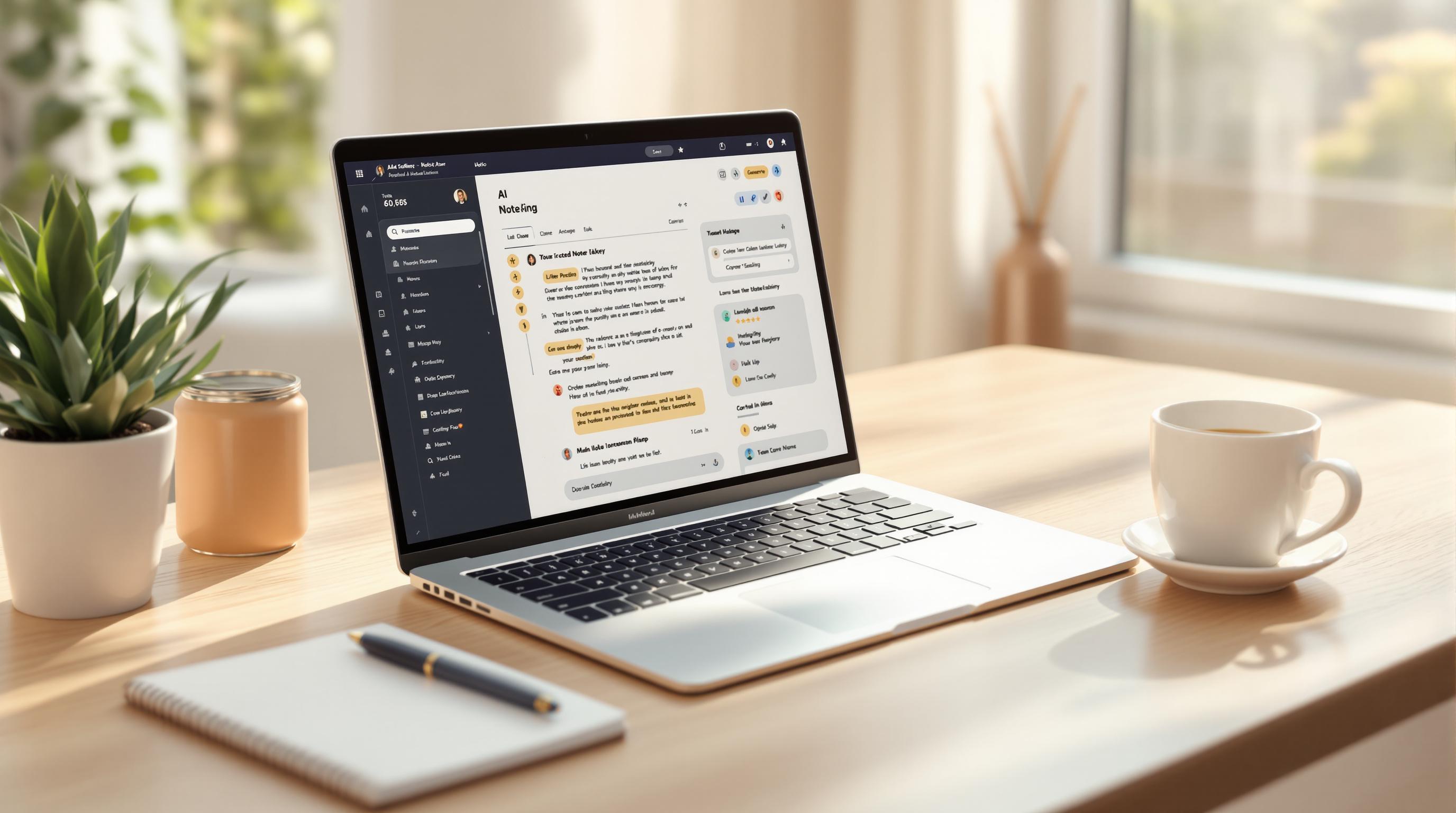Appearance
AI Note-Taking Tools: Common Problems and Solutions

AI note-taking tools like Otter.ai and Notion AI are transforming how we capture and organize meeting, lecture, and discussion content. However, these tools face significant challenges:
- Speech Recognition Errors: Misunderstandings due to accents, jargon, or poor audio quality.
- Context Understanding: Struggles with sarcasm, cultural references, and specialized terms.
- Data Privacy Risks: Concerns about sensitive information and compliance with laws like GDPR and CCPA.
- Software Integration Issues: Problems syncing with existing tools or workflows.
Quick Overview of Solutions:
- Improving Accuracy: Use custom vocabularies, better microphones, and quiet environments.
- Enhancing Context Understanding: Leverage tools with speaker identification and real-time reviews.
- Strengthening Security: Enable two-factor authentication and adjust sharing permissions.
- Streamlining Integration: Use APIs and automatic syncing features.
AI tools are improving but still require user effort to overcome these issues. Read on to explore detailed strategies and tools like Ticknotes, which addresses these challenges with features like smart transcription, sentiment analysis, and secure data handling.
How I Use AI to Take Perfect Notes Without Typing
4 Main Problems with AI Notes
AI note-taking tools are becoming more common, but they still face challenges that can limit their effectiveness and even hinder productivity in some cases.
Speech Recognition Errors
One of the biggest hurdles is speech recognition. For non-native speakers, error rates can climb as high as 20% [1]. This is a serious issue in professional environments where accuracy is non-negotiable.
| Issue Type | Impact | Example Scenario |
|---|---|---|
| Language and Terminology Challenges | Misunderstanding words | Accents or technical jargon leading to mistakes |
| Audio Quality Issues | Inaccurate transcription | Background noise or overlapping voices causing errors |
Even when the transcription is mostly correct, understanding the true meaning behind the words remains a tough problem.
Meaning and Intent Errors
AI often struggles with context, which can lead to major misunderstandings. These tools frequently miss nuances like:
- Sarcasm or humor
- Specialized industry terms
- References tied to specific cultural contexts
Such gaps can distort the original intent of a conversation, making the notes less reliable [2].
Data Security Risks
Although many tools claim to use encryption and meet compliance standards, risks like unauthorized access or incomplete privacy safeguards still exist. Professionals need to carefully assess how secure these tools are before relying on them for sensitive information.
Software Integration Issues
Integration challenges usually fall into two categories:
- Technical Compatibility: Problems with syncing data or handling different file formats
- Workflow Disruptions: Interruptions caused by tools not aligning with established processes
Some tools attempt to ease these issues with APIs or built-in platform connections, but they don't always fully resolve the problems. Overcoming these hurdles often requires both technical fixes and careful planning, which will be discussed in the next section.
How to Fix Common AI Note Problems
Improving Speech Recognition
Boosting speech recognition accuracy can make a big difference in your AI note-taking experience. Using custom vocabulary training, quiet environments, and proper microphone placement are key steps. Here's a quick breakdown:
| Method | Impact | How to Apply |
|---|---|---|
| Custom Vocabulary | Up to 30% better accuracy | Add specialized terms in the tool's settings |
| Environment Control | Reduces noise interference | Choose quiet spaces; use sound-absorbing materials |
| Microphone Optimization | Clearer audio capture | Place the mic 6-12 inches from the speaker |
These steps not only improve transcription but also ensure the notes reflect the intended message accurately.
Ensuring Accurate Context
Modern tools like Jamie AI are designed to recognize individual voices, which is especially useful in meetings with multiple participants [4]. This helps attribute dialogue to the right speaker and makes tracking conversations smoother. For better context accuracy, use features like speaker identification, real-time transcript reviews, and topic tracking.
Strengthening Data Security
When using AI tools, protecting your data is non-negotiable. Platforms like Fathom and Fireflies come equipped with advanced security features, such as 256-bit AES encryption and compliance with SOC 2 Type II and GDPR standards [2]. Here’s how to keep your notes secure:
- Enable two-factor authentication for account protection.
- Adjust sharing settings to control who can access your notes.
- Regularly check access logs and user permissions to prevent unauthorized access.
By taking these precautions, you can ensure your data stays safe while using AI tools.
Streamlining App Integration
Fireflies is a great example of seamless integration, connecting effortlessly with platforms like Zoom, Google Meet, and Slack [3]. To make the most of app integrations:
- Check for API compatibility between your tools.
- Set up automatic note syncing to keep everything organized across platforms.
These steps help ensure your tools work together smoothly, saving you time and effort.
sbb-itb-04becac
Ticknotes: Features and Uses

Main Ticknotes Functions
Ticknotes stands out by addressing common challenges in AI-driven note-taking, particularly in secure data management and advanced analytics. It uses AI to transform various types of content into meaningful insights, cutting down on manual work.
Here’s a closer look at its key features:
| Feature | Description | Benefit |
|---|---|---|
| Smart Transcription | Provides accurate multi-speaker transcription | Saves up to 40% of manual editing time |
| Sentiment Analysis | Tracks engagement and emotional tone in real-time | Helps evaluate meeting effectiveness |
| Document Chat | Enables interactive Q&A with your notes | Simplifies information retrieval |
| Multi-format Support | Handles audio, video, and PDF formats | Adapts to different content types |
Ticknotes also uses advanced natural language processing (NLP) to reduce context errors, particularly in technical conversations. Its specialized algorithms are designed to handle industry-specific terms effectively [4].
Cost and Plan Options
Ticknotes provides flexible pricing plans to cater to a variety of users:
| Plan | Monthly Cost | Key Features | Best For |
|---|---|---|---|
| Basic | Free | Basic transcription and summarization | Individual users and students |
| Pro | $9.99 | Improved security and advanced analytics | Professionals and small teams |
| Enterprise | Custom | Custom integrations and priority support | Large organizations |
The Pro plan is ideal for professionals, offering encryption and sharing controls to ensure secure data management [2]. For larger organizations, the Enterprise plan provides tailored solutions, including vulnerability assessments and enhanced data protection protocols.
Ticknotes prioritizes user privacy by ensuring customer data isn’t used for AI training without explicit consent [5]. This makes it a reliable choice for managing sensitive information in professional environments.
Conclusion
AI note-taking tools are advancing quickly, tackling key challenges while prioritizing user privacy and data security. Improvements in speech recognition and context understanding have made these tools more dependable for professional settings. While progress has been notable, there are still areas that need attention.
These tools are evolving in two key areas:
| Area | Current Status | Future Enhancements |
|---|---|---|
| Accuracy and Context Understanding | 85-90% accuracy with clear audio; basic topic tracking and summarization | Advanced semantic analysis and intent recognition |
| Data Security | Standard encryption and access controls | Zero-knowledge encryption and detailed permission settings |
Despite these strides, challenges like organizational bias persist. For example, some systems may favor senior participants in meetings, giving their input more weight [1]. To tackle this, developers are refining algorithms to focus on content relevance rather than speaker hierarchy, ensuring fair representation for all users.
Looking ahead, the combination of AI and human review offers a balanced approach, enhancing both accuracy and context. As natural language processing and integration capabilities improve, we can anticipate tools that address existing shortcomings and deliver even more refined features.
FAQs
How to improve Otter.ai transcription?

Boosting Otter.ai's transcription accuracy can be achieved through a few practical steps:
- Speaker Identification: Use Otter's settings to tag and train the tool to recognize individual speakers. This helps improve the accuracy of speaker labels in transcripts.
- Custom Vocabulary: Add industry-specific terms and commonly used phrases to Otter.ai's vocabulary. This is especially helpful for technical or niche discussions.
- Audio Quality: Follow tips for optimizing audio quality, like reducing background noise and using high-quality microphones, to get better transcription results.
How safe is AI note taker?
The safety of AI note-taking tools depends on how they're set up and used. Here's a quick look at key security aspects:
| Security Aspect | Risk Level | Mitigation Strategy |
|---|---|---|
| Data Privacy | High | Use private networks and set session restrictions. |
| Meeting Confidentiality | Medium | Enable pause features and avoid sensitive sessions. |
| Legal Compliance | High | Obtain consent and follow GDPR/CCPA regulations. |
For safer usage, consider these steps:
- Keep Software Updated: Regularly install updates and security patches.
- Control Access: Set up authentication and manage sharing permissions.
- Secure Networks: Use encrypted or private networks for sensitive discussions.
- Notify Participants: Inform everyone when AI tools are recording.
Keep in mind that laws vary by location. For example, the California Consumer Privacy Act (CCPA) requires specific compliance measures when using AI-powered tools for recording and transcription [6].

